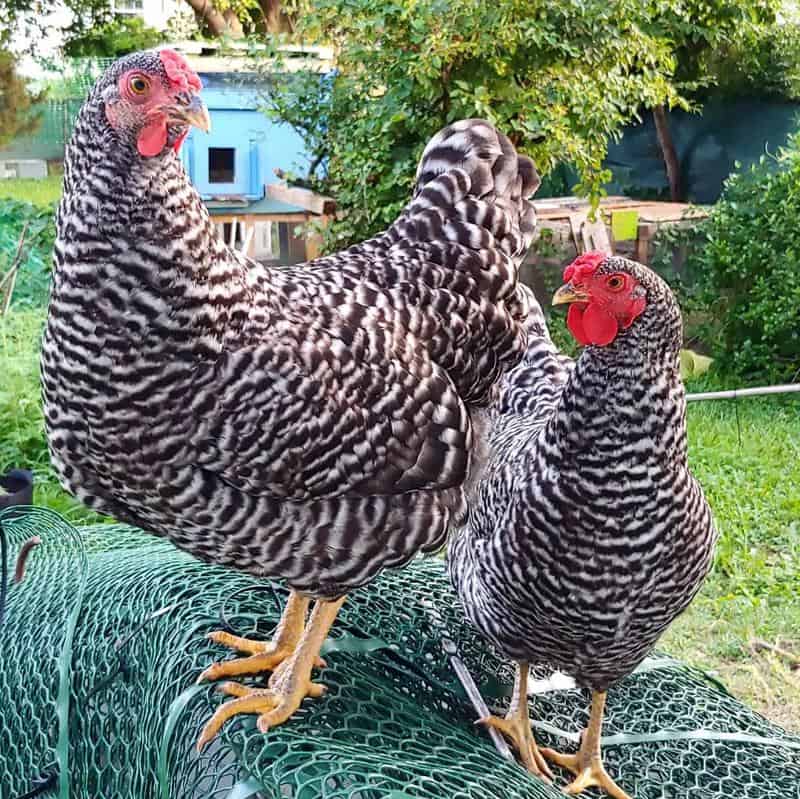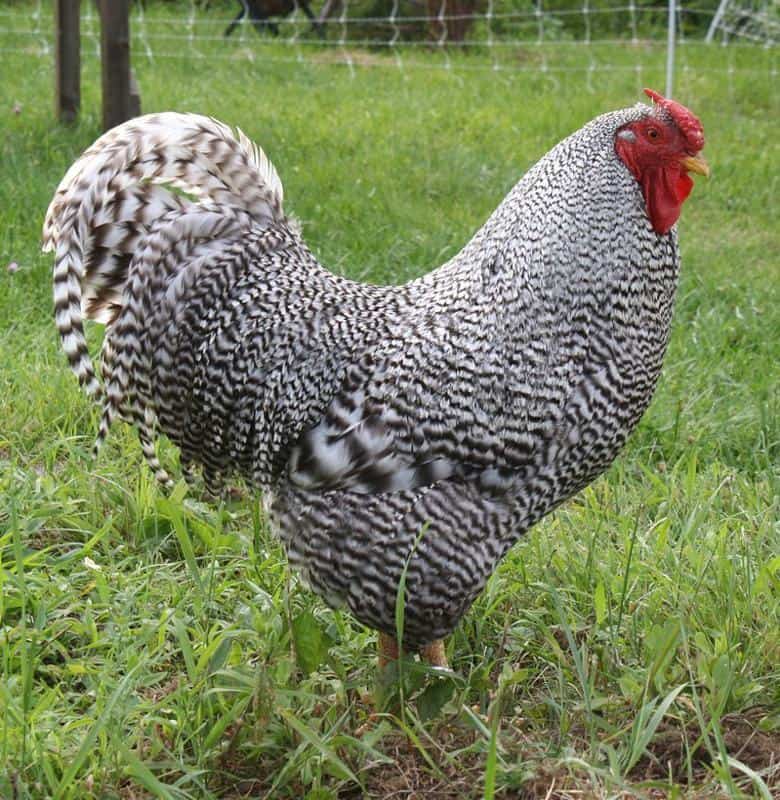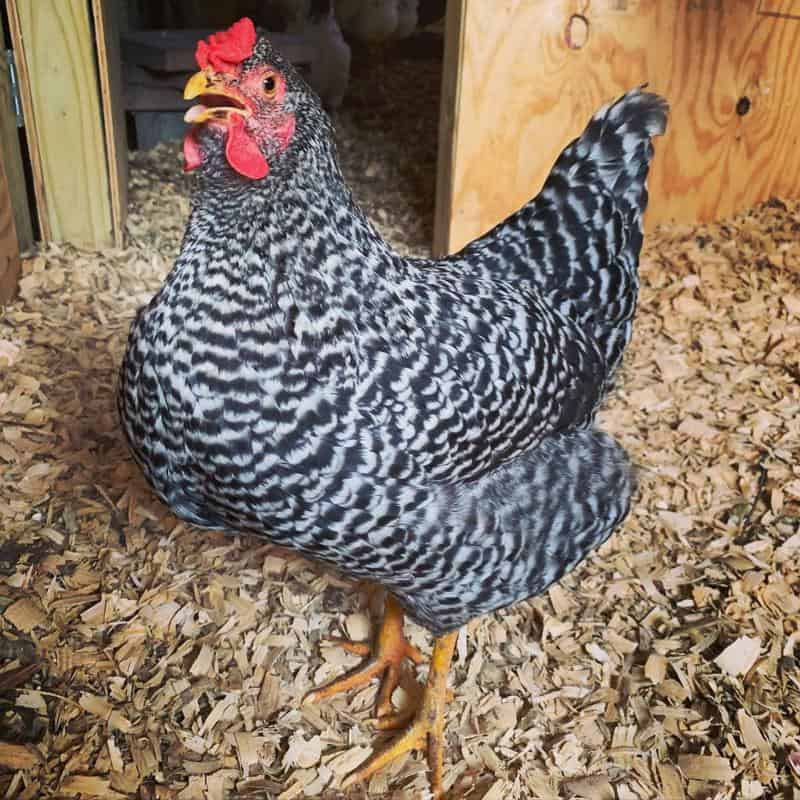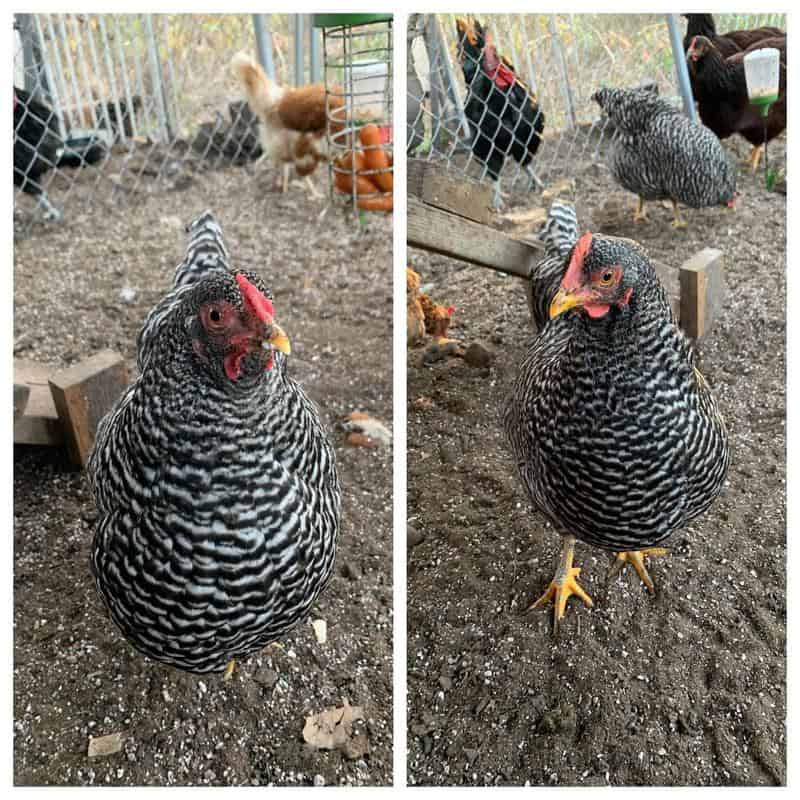The Dominique is as American as chicken gets. It was, after all, the very first chicken breed developed in the North American country now seen by many as the Mecca for all things chicken.
These mid-sized birds are rarer today than you would expect of something of its status. For a time, there was a real risk that they would go extinct, but things have improved for Dominickers in recent decades.
Dominique chickens don’t have the variety of other breeds and only one plumage color is currently recognized. Even so, they remain some of the best backyard chickens, especially for those starting out in poultry keeping.

We take a deep dive into the origins of a classic American bird and how you can get the best out of it on your farm today.
Dominique Chickens Quick Facts
| Names | Dominiques, Dominickers, Dominic, Blue Spotted Hen, Pilgrim Fowl, Old Grey Hen |
| Origin | USA |
| Purpose | Eggs and Meat |
| Egg Production/Year | 180 – 260 |
| Climate | Cold and Heat Hardy |
| Plumage Color | Light and dark barring |
| Max Weight | Hens: 5 lbs.
Roosters: 7 lbs. Pullets: 4 lbs. |
| Personality | Docile and Friendly; Roosters may get aggressive during mating season. |
| Unique Fact | In the past, Dominique Chickens’ owners used their feathers for featherbeds and pillows. |
The History of Dominique Chickens
Possible Origins
There are different schools of thought regarding the origins of Dominique Chickens.
Some believe that these chickens were the offspring of birds that colonists brought with them to the United States when they arrived from England. These could have been birds bearing some similarities to the present-day Sussex and Dorking Chickens.
The other theory has it that these chickens came from modern-day Haiti. Back in the day, Haiti was a French colony that went by the name Saint Domingue.
Names
Thanks to their appearance and the different theories surrounding their origins, Dominique chickens have gone by many names including:
- Dominickers
- Dominics
- Pilgrim Fowls
- Blue Spotted Hens
- Old Grey Hens
Spread and Standardization
Today, Dominique Chickens are recognized as the oldest American breed of chicken. These birds have existed on American farms since at least the mid-1700s and were common by the 1820s.
Dominique Chickens featured in the 1849 American Poultry Show which was held in Boston. This was the first such event held on American soil.
It was later decided that only chickens with rose combs would be recognized as Dominiques and those with single combs would be considered Barred Rocks.
The Dominique breed was admitted into the Standard of Perfection in 1874.
Perhaps the most significant legacy of the Dominique Chicken is that it was used to develop the Plymouth Rock chicken. This is why the Barred Rock, the original Plymouth Rock Chicken, bears such a significant resemblance to the Dominique.
Decline of Dominique Chickens
The Dominique’s presence on American farms started to decline in the early 1900s. Several factors have been attributed to this including:
- The deaths of long-time breeders and fanciers of the breed.
- The rise of the Barred Rock
Despite these factors, the breed held on through the Great Depression when it was popular due to its hardiness, and during the Second World War. Unfortunately, the rise of industrial farms pushed this breed even further to the side.
By the 1970s, only four flocks that were suitable for breeding remained in the US.
Recovery
Together with The American Livestock Breeds Conservancy, today known as The Livestock Conservancy, some individuals reached out to the owners of the remaining flocks of Dominique Chickens.
They convinced them to participate in an effort to save the breed from extinction. These efforts resulted in the formation of the Dominique Club of America (1973) and the rescue of several old bloodlines.
The breed’s numbers have been rising steadily ever since and they are no longer critically endangered.
Appearance of Dominique Chickens
Plumage
The Dominique has only one recognized plumage color and it features a pattern that is known as cuckoo. This plumage pattern consists of feathers with alternating light and dark barring.
This plumage pattern is quite useful since it makes Dominique chickens less noticeable to predators. It is sometimes called hawk coloring.
The breed has close feathering with offers great insulation in winter.
Comb
For a chicken to be considered a Dominique, it must have a rose comb. The rose combs on these birds have a low profile and a short spike that curves upwards.
Size
Dominique Chickens are mid-sized birds. The males will, on average, weigh 6 to 7 pounds while the females weigh between 4 and 5 pounds.
There is a bantam version of the Dominique Chicken which has been officially recognized by the APA since 1960. These weigh between 700 and 800 grams, i.e., 24.7 – 28.2 ounces.
Hens vs Roosters

Dominique Roosters carry their tail feathers higher than other American breeds. Their backs form an almost perfect ‘U’ outline. Their bodies are full and broad and a rooster can be between 2 and 4 feet tall.
The hens have backs that seem to slope all the way from their heads to their tails.
Both the hens and roosters have bright red wattles, combs, faces, and earlobes, with yellow skins, beaks, feet, and legs.
Dominique Chickens as Layers
How Many Eggs Can Dominique Chickens Lay in a Year?
Dominique Chickens were mainly kept as layers although they are classified as dual-purpose chickens. These birds have been known to lay as many as 275 eggs in a single year.
Because egg laying is affected by a wide range of factors, you can realistically expect around 200 eggs in a year.
When Do Dominique Chickens Start Laying?
Dominique Chickens will start laying eggs at around 6 months of age. This is typically between their 21st and 24th week.
As always, there will be exceptions, and some will start earlier or later.
What Size are the Dominique Chickens Eggs
Dominiques lay medium to large eggs that weigh an average of 58 grams.
What Color is the Dominique Chicken’s Eggs?
Dominique chickens lay brown eggs.
Are Dominique Chickens Good Meat Birds?
Most farmers may keep Dominiques with egg-laying in mind, but these chickens can also serve as valuable meat birds.
The meat from these chickens has been described as having exceptional flavor. Additionally, because they are mid-sized birds, you can expect an appreciable amount of meat from a mature hen or rooster.
Raising Dominique Chickens

Dominique Chickens have a long-standing reputation as one of the hardiest breeds on the farm. Farmers have been able to keep these birds with few challenges even during harsh economic times.
With the lean days of The Great Depression behind us, you can afford to take even better care of your Dominiques. Likewise, you can expect a lot more from them when they receive a higher quality of care.
Housing and Environment
Dominique Chickens are hardy and can cope with both hot and cold climates. To ensure your chickens are as productive as possible, keep the following factors under consideration:
- Dominiques are good foragers and will thrive in a backyard farm with plenty of space to roam. However, if you lack the space, they can also tolerate confinement.
- Dominique hens are good layers. Ensure you have enough nesting boxes to accommodate all your laying hens and pullets.
- Dominique’s are mid-sized birds so 12-inch nesting boxes will be enough for hens.
- Dominique Chickens’ rose combs make them less susceptible to frostbite. For good production results, you should still take measures like preventing drafts, installing adequate ventilation, and increasing their bedding during winter for extra comfort.
- There should be 1 foot of roosting space for each chicken in the coop and the roosts should be between 2 and 4 feet off the ground.
- You should have at least 10 square feet of space per bird in the run.
- Ensure your fences are high enough, at least six feet, to keep the chickens from flying out and to keep predators from jumping in.
- Amenities like dust baths and perches are also great for breeds with traditional chicken behavior like Dominiques.
What Do You Feed Dominique Chickens?
These hardy birds are unlikely to stick their nose up at anything you offer them. They love to forage, and their normal diet can consist of grains, grass, fruits, bugs, etc.
It is still a good idea to provide regular chicken feed for your birds and these can be pellets, mashes, or crumbles. This guarantees that your Dominiques are getting their daily recommended intake of essential nutrients.
Laying Dominique hens should be fed a nutrient-rich layer mash to ensure they stay healthy as they keep your home supplied with eggs. The demands of egg laying can deplete many nutrients within the hens’ bodies leading to health problems.
Calcium deficiency is one of the key concerns with layers like Dominiques. You can supplement their calcium intake using crushed eggshells or oyster shells.
Temperament
Dominique Chickens are a very friendly breed and are even recommended for children and new farmers. For those interested in one, these chickens can make a great pet for the family.
Dominique roosters don’t have a reputation for being aggressive towards people. However, they can show some aggression, especially towards other roosters, when mating season comes around.
You can lower the problem of aggression by maintaining a good ratio of roosters to hens. The recommended ratio is 1 rooster for every 10 hens.
Lifespan of Dominique Chickens
As with most Heritage chicken breeds, Dominiques have a lifespan of between 6 and 8 years. They can live even longer when raised under the right conditions.
For the hens, you should note that egg production will decline over time. This is expected after the first two years.
Breeding and Broodiness in Dominique Chickens
Broodiness
Brooding behavior in Dominique Chickens is surprisingly inconsistent. Some hens may be inclined to go broody while others won’t.
The variability is said to be dependent on the line of Dominiques your hen is descended from.
Another fact is that when Dominiques do go broody, they turn out to be very good mothers to their chicks.
Breeding
Dominiques are true breeds and the offspring of two Dominiques will be a Dominique. Additionally, Dominique males and females are easy to tell apart after hatching because it is an autosexing breed.
Most of the down on both males and females will be black and both have a white spot at the top of their heads. However, the spots on the hens’ heads are more compact, i.e., have a well-defined edge while the spots on the roosters are diffuse.
Additionally, Dominicker roosters have yellow feet while the hens have grey feet.
Other breeding-related facts about Dominique Chickens are:
- The chicks hatch well and develop feathers quickly.
- Dominique chicks mature quickly.
Dominiques vs Barred Rocks

As stated earlier, the Plymouth Rock chicken breed was derived from Dominiques. Plymouth Rocks were the result of crossing Dominickers with Black Javas.
The first Plymouth Rock was the Barred Rock and, as its name suggests, it has a barred plumage like the Dominique’s. However, there are several differences between these two breeds today including:
- Dominique Chickens have rose combs and Barred Rocks have single straight combs.
- The plumage of Barred Rocks is made up of straight, alternating white and black bars that have approximately the same width. The barring in the cuckoo plumage of Dominiques is more irregular and the dark parts are closer to grey.
- Dominique roosters are significantly lighter than Dominique hens because of their wider white bars. Barred Rock roosters are only slightly lighter than Barred Rock Hens.
- Barred Rocks are heavier and larger than Dominique chickens of the same age.
- Dominique Roosters have longer tails than Barred Rock roosters.
Finally, on average, Barred Rocks lay more eggs than Dominiques. The eggs of Barred Rocks are also large while those of Dominiques can be medium or large.
One interesting fact is that the distinction between the different combs was not made until 1870. Prior to that year, there were single-combed chickens that were considered Dominiques.
In 1870, during the New York State Poultry Show, it was decided that only the rose-combed fowls of intermediate size would be considered Dominiques. Medium-sized or larger birds with single combs would be considered Plymouth Rocks.
The Fight to Save the Dominique Chicken
Today, Dominique Chickens’ status is listed as ‘Watch’ by the Livestock Conservancy. This means that there are still fewer than 10,000 Dominique Chickens around the world.
Dominique Chickens played a pivotal role in the establishment of the poultry industry in the US. They gave rise to the Plymouth Rock which was once the most widely kept chicken breed in the country and was also used to develop modern broilers.
Due to their population decline, there was significant inbreeding in the efforts to preserve the species. This may have reduced the genetic diversity of Dominiques available today.
Luckily, organizations like the Dominique Club provide their members with guidelines to avoid excessive inbreeding of their stocks.
Read More:
The Original American Chicken
The US has a rich history of great backyard chicken breeds. The Dominique will always hold the title as the very first of these.
Dominiques quickly established itself as an excellent backyard chicken thanks to its egg-laying potential and its hardiness. These chickens have been known by many names and are still fondly called Dominickers.
Dominique Chickens fell out of favor in the early 20th century and almost went extinct. However, the efforts of various parties saved the breed.
Dominique Chickens are considered an excellent option for the new farmer because they are hardy, love to forage, and are usually calm in their coops. They also do well in all sorts of climates.
As a farmer, you’ll be able to enjoy both these chickens’ plentiful eggs and their tasty meat. However, keeping these chickens isn’t only about their production potential, it’s about preserving the breed that started it all.
